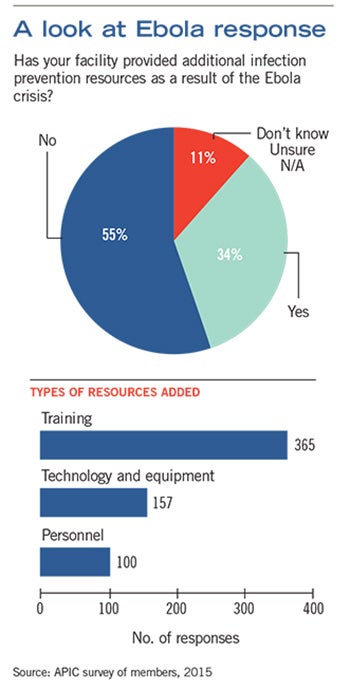Survey shows hospital staff are better trained to confront Ebola
 Infection prevention and control (IPC) leaders say their facilities are more prepared today than a year ago to handle a patient with a highly infectious disease like the Ebola virus, but ICP leaders are concerned that many organizations are not providing adequate manpower resources to protect patients and health care workers.
Infection prevention and control (IPC) leaders say their facilities are more prepared today than a year ago to handle a patient with a highly infectious disease like the Ebola virus, but ICP leaders are concerned that many organizations are not providing adequate manpower resources to protect patients and health care workers.
These were two of the key underlying messages in the data from a survey of Association for Professionals in Infection Control and Epidemiology (APIC) members. The survey, which drew responses from 981 of APIC’s 15,000 members, was conducted in September and released in November to determine ongoing needs a year after the first Ebola patient was admitted to a U.S. hospital.
In all, 92 percent of infection control leaders responding to the survey said they believed their facilities are better prepared than a year ago to deal with a patient with a highly infectious disease like the Ebola virus. Similarly, 94 percent felt more prepared than a year ago to implement processes and procedures to protect staff and patients should their facility receive a patient with a highly lethal infectious disease.
Respondents were slightly less confident about whether their facility had sufficient personal protective equipment to meet the Centers for Disease Control and Prevention’s guidelines for the care of Ebola patients. Three in four respondents felt their facility met this standard.
Obviously still aware of the potential need for staff to be able to effectively manage Ebola patients, 62 percent of the respondents said they have continued to train their staffs over the past year to handle patients with a highly infectious disease.
Still, a large question remained: Have facilities provided additional IPC resources as a result of the Ebola crisis? Slightly more than half (55 percent) of respondents said their facility had added IPC resources since the first Ebola patient came to this country. Of these, 45 percent work in facilities with more than 100 beds. As a result of the Ebola crisis, 10 percent of respondents received additional personnel from their facilities, and a third (37 percent) received support for staff training programs on infection control protocols.
“We are encouraged to learn that our members feel their facilities are more prepared to handle patients with highly lethal infectious diseases, and to know that some infection prevention and control departments have obtained additional staff and resources,” says Susan Dolan, R.N., CIC, president-elect of APIC and hospital epidemiologist at Children’s Hospital Colorado. “But with the ongoing threat of emerging infectious diseases and antibiotic-resistant organisms, we remain concerned that many facilities are lagging behind in providing adequate IPC staffing support to protect patients and health care workers. We urge health care leaders to assess the needs of their infection prevention programs and dedicate the necessary staff, training, and technology resources to this critical area.”




